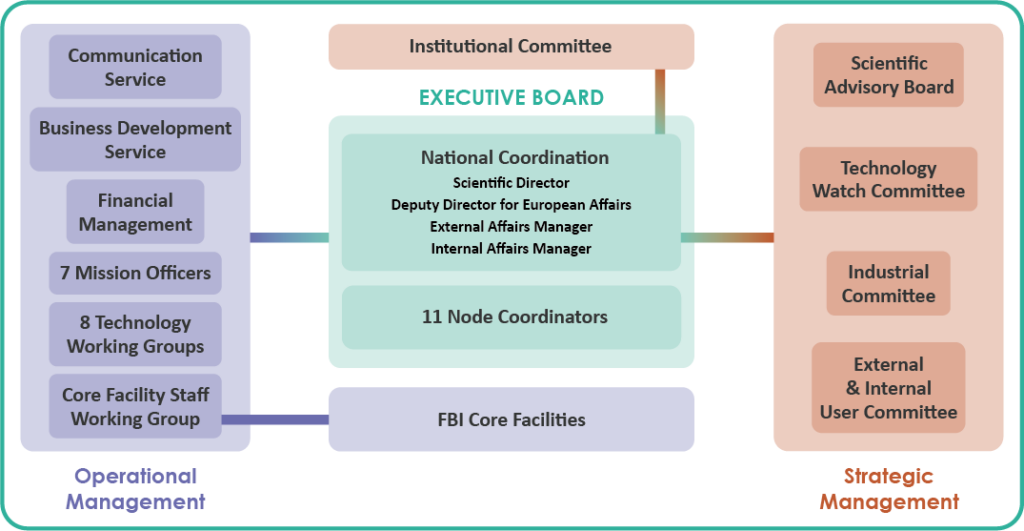FBI governance chart and national coordination structure

FBI governance bodies
The Executive Board comprises the National Coordination, the nine node coordinators or their substitutes, and Representatives of the FBI core Facilities. According to the topics to be addressed, members of the National Advisory Committee are invited
Scientific Director: René Marc MEGE
Former Scientific Director: Edouard BERTRAND
Deputy Director for National Affairs: Virgile VIASNOFF
Deputy Director for International Affairs: Yves MELY
Internal Affairs Manager: Alexandre PHILIPS
External Affairs Manager: Caroline THIRIET
Support function:
Communication Assistant: Marine BERAUD
Business Developer: Samy AL-BOURGOL
Mission Officers:
- Mission « Structuration Noeuds Franciliens »: Jean SALAMERO
- Mission « Action inter-infrastructures »: Jean SALAMERO
- Mission « Image data »: Perrine PAUL-GILLOTEAUX & Emmanuel FAURE
- Mission « Training »: Fabrice CORDELIERES
- Mission « Intégration plateforme / e-Managment »: Cédric MATTHEWS
- Mission « R&D et tech transfert »: Etienne HENRY
Nodes Heads
- Paris Centre: René Marc MEGE (substitute: Nathalie AULNER)
- Île-de-France Sud: Sandrine LECART (substitute: Emmanuel BEAUREPAIRE)
- Marseille: Pierre-François LENNE (substitute: Didier MARGUET)
- Montpellier: Emmanuel MARGEAT (substitute: Patrick LEMAIRE)
- Bordeaux: David PERRAIS (substitute: Fabrice CORDELIERES)
- Bretagne-Loire: Marc TRAMIER (substitute: Perrine PAUL-GILLOTEAUX)
- Alsace: Yves MELY, Bertrand VERNAY
- Toulouse: Olivier GADAL, Cécile POUZET & Jacques ROUQUETTE
- Normandie: Ludovic GALAS & Isabelle BARDOU
- Rhône-Alpes: Olivier DESTAING & Jacques BROCARD
- Bioimage Informatics: Charles KERVRANN & Jean-Yves TINEVEZ, project manager: Perrine PAUL-GILLOTEAUX
Core F. Representatives
- Audrey SALLES ( UTechS PBI, Institut Pasteur, Paris Centre)
- Nicolas BROUILLY ( PicSL, IBDM, Marseille)
Day to Day work, Management, Support decision, Process Plan, Networking & Communication, Landscape perimeter, Working plan.
- Monthly EB meetings (Visio conf)
- On-site visits
René Marc MEGE
“Cell Adhesion and Mechanics” lab
INSTITUT JACQUES MONOD
Université de Paris – CNRS
Bâtiment Buffon – 15 rue Hélène Brion
75205 Paris
rene-marc.mege@france-bioimaging.org
Edouard BERTRAND
Scientific Director
IGMM – CNRS UMR5535 – Montpellier
edouard.bertrand@france-bioimaging.org
Alexandre PHILIPS
Internal Affairs Manager
Montpellier
alexandre.philips@france-bioimaging.org
Caroline THIRIET
External Affairs Manager
Bordeaux Imaging Center
Université de Bordeaux
Centre Génomique Fonctionnelle Bordeaux
1er étage – case 52 146
146 rue Léo Saignat,
CS 61292 – 33076 Bordeaux Cedex
caroline.thiriet@france-bioimaging.org
Support Function:
Marine BERAUD
Communication Assistant
Bordeaux Imaging Center
Université de Bordeaux
Centre Génomique Fonctionnelle Bordeaux
1er étage
146 rue Léo Saignat,
CS 61292 – 33076 Bordeaux Cedex
marine.beraud@france-bioimaging.org
communication@france-bioimaging.org
Samy AL-Bourgol
Business Developer
Bordeaux Imaging Center
Université de Bordeaux
Centre Génomique Fonctionnelle Bordeaux
1er étage
146 rue Léo Saignat,
CS 61292 – 33076 Bordeaux Cedex
samy.al-bourgol@france-bioimaging.org
Mission Officers:
- Mission « Structuration Noeuds Franciliens » : Jean Salamero
- Mission “Action inter-infrastructures”: Jean Salamero
- Mission “Image data”: Perrine Paul-Gilloteaux & Emmanuel Faure
- Mission “Training”: Fabrice Cordelières
- Mission « Intégration plateforme / e-Managment »: Cédric Matthews
- Mission « R&D et tech transfert »: Etienne Henry
The NAC is composed of three bodies representing users, the industrial community and technological networks.
National User Committee
The NUC is composed of users of our facilities who do not belong to the France BioImaging perimeter. It gives completely independent recommendations and suggestions on the user-related activities of FBI.
External users representatives:
- Bordeaux Node:
- Dirk Schaumlöffel (Institut des Sciences Analytiques et de Physico-Chimie pour l’Environnement et les Matériaux (IPREM) UMR 5254 / LCABIE, Université de Pau)
- Harald Wodrich (Laboratoire de Microbiologie Fondamentale et Pathogénicité UMR-CNRS 5234, Inserm, Bordeaux)
- Ile de France Sud Node:
- Laure Crabbé (Université Paris-Saclay)
- Marseille Node:
- Emmanuelle Renard (Institut Méditerranéen de Biodiversité et d’Ecologie marine et continentale, IMBE UMR 7263, Marseille)
- Lionel Berthaux (UMR 7256 Information Génomique et Structurale, Marseille)
- Jenifer Croce (Observatoire de Villefranche-sur-Mer)
- Montpellier Node:
- Silvia Zorrilla (Consejo Superior de Investigaciones Científicas, CSIC, Madrid)
- Jean-Yves Bouet (Centre de Biologie Intégrative de Toulouse)
- Paris-Centre Node:
- Jennifer Gommerman (University of Toronto)
- Guillaume Pidoux (Inserm/Paris-Saclay/Chatenay Malabry)
- Sandra Piquet (UMR7216 CNRS Université Paris Diderot)
- Nicolas Chevalier (Matière et Systèmes Complexes, Université Paris Diderot)
- Guillaume van Niel (Centre de Psychiatrie et Neurosciences, U-894 INSERM)
The NUC allows FBI to keep in contact with the overall national community involved in the development of imaging instruments and methods in R&D labs and core facilities. NUC stands several times a year, in order to consider and include user recommendations and suggestions in the overall improvement of the infrastructure.
FBI Industry Committee (IC)
The IC is composed of local representatives of companies involved in field of microscopy, from start-ups to big conglomerates.
President: Fabrice Schmitt (Zeiss)
Vice-President: Martin Belle (CryoCapCell)
Representatives of:
The IC gives recommendations and suggestions on the direction of industrial partnerships initiated by FBI. It is also actively involved in the implementation of FBI’s integrated training offer, as members of the IC have noticed the need to gather and coordinate efforts to provide the best training, from fundamental knowledge to practical skills, in order to create a virtous circle that benefit the whole community.
The IC follows rules of procedure defining its organization.
Please click here to consult the Rule of Procedure document.
National “Tech Watch” Committee
The National Tech Watch committee is composed of representatives of the technological networks and research groups (GDR) in our field. It allows for the coordination of the communities specialized in biological imaging technologies and methodologies. FBI has signed partnerships conventions with the RIME and RTmfm networks. The “Tech Watch” committee gathers the whole community of biological imaging, beyond the official FBI’s perimeter.
These networks (and others) branch out into regional and local scales. FBI’s dissemination and animation activities are also inscribed in such local contexts (PhysChemCell, Light Sheet Microscopy, Storage Day in collaboration with IFB, chemical cell imaging, RIC Paris-Saclay, etc.)
Networks Representatives
- RIME: Bruno PAYRE, Nathalie MESMER-DUDONS
- RTmfm: Aurélien DAUPHIN, Christine TERRYN
- GDR IMABIO: Laurent HELIOT
The FBI node community is composed of all the Core-facility and R&D staff. They are at the heart of the France BioImaging activities, and as such, are a pivotal source of information to shape FBI’s strategies. In 2019, a dedicated CoreF WG was created, Its role is based on the node COMMUNITY tasks. Their representatives are permanently invited to the Executive Board (Executive Committee)
CF WG Representatives : Audrey SALLES, Nicolas BROUILLY
The Node Community is composed of all the FBI platform heads of staff.
The Node Community runs the daily activities of the core-facility and R&D platforms.
The SAB is composed of six independent and eminent members of the scientific community in the field of biological imaging, from abroad.
President: Dr. Teng-Leong Chew (HHMI, AIC Janelia farms, USA)
- Dr. Scott Fraser (USC, LA, USA)
- Dr. Peter Dedecker (KU, Leuven, Belgium)
- Dr. Emma Lundberg (KTH Stockholm, Sweden)
- Dr. Francesco Pavone (LENS, Florence, Italy)
- Dr. Lucy Collinson (Crick Institute, London, UK)
- Dr Claudine Médigue (Genoscope, Evry, France)
The SAB gives recommendations and suggestions on the scientific perimeter and technological developments carried out by FBI, but also on the efficiency and pertinence of both service and technological transfer from R&D teams to the Imaging Core Facilities open to users.
The SAB examines the results and projects of the infrastructure every 2 years, evaluates progresses, strengths and weaknesses, and proposes new avenues of service opening and offer, scientific investigation and technological development.
The institutional committee involves representatives of all signatories of the Consortium Agreement.
Representatives of:
- CNRS
- Université Paris Cité
- Aix-Marseille Université
- Institut Pasteur
- Inria
- Institut d’Optique Graduate School
- Université de Bordeaux
- Généthon
- Université de Montpellier
- Collège de France
- Institut Curie
- Institut Gustave Roussy
- Université de Rennes 1
- Ecole Normale Supérieure
- Sorbonne Université
- Nantes Université
- Université Paris-Saclay
- Ecole Polytechnique
- Inserm
- Université de Strasbourg
- Université de Haute-Alsace
- Université Toulouse 3 Paul Sabatier
- Université Grenoble-Alpes
- Université Claude Bernard Lyon 1
- Université de Rouen
- Université de Caen Normandie
- Université Le Havre Normandie
The Institutional Committee takes responsibility of decisions concerning major changes in orientation, composition, evolution and sustainability of the national infrastructure FBI.
It is also convened in case of major conflicts between members of the Executive Board.
For all the above reasons, the national coordinator informs the main supervising institution of FBI, the CNRS. Then, the CNRS notifies the other Parties and organizes debates and meetings. Final, the Institutional Committees takes decision, if necessary.
